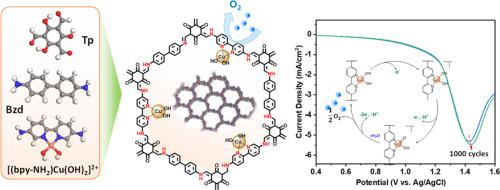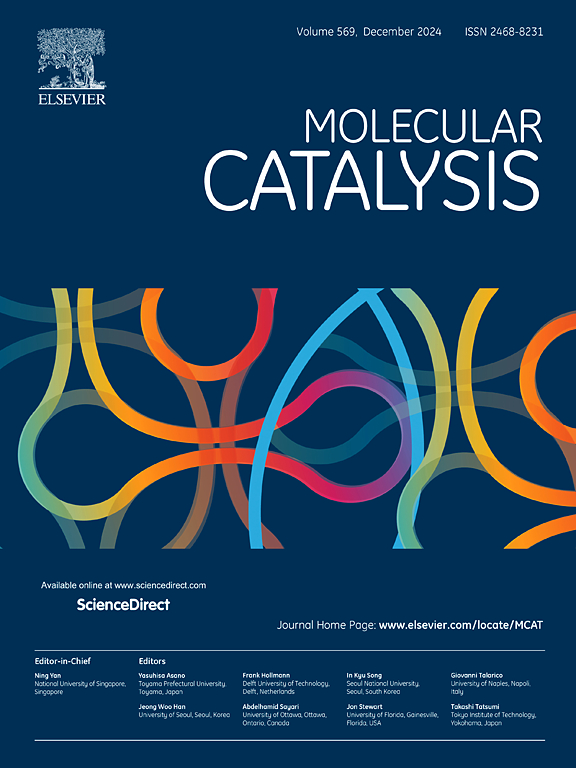Molecular complex inspired design of an efficient copper(II)-containing robust porous polymers for electrochemical water oxidation
IF 3.9
2区 化学
Q2 CHEMISTRY, PHYSICAL
引用次数: 0
Abstract
Homogeneous copper-bipyridine complexes have been reported as effective catalysts for water oxidation, demonstrating significant potential as alternatives to precious metal-based complexes. However, these complexes face long-term stability and product separation challenges similar to many homogeneous catalysts. Meanwhile, recent studies have underscored the potential of metalated polymer networks, which integrate the structural advantages of polymers with the functional benefits of metal species, making them highly attractive for various applications. Herein, we integrated copper-bipyridine units into porous polymer networks to overcome the limitations of copper-bipyridine complexes. We prepared a series of copper-incorporated polymers (TpBpy-Cux) for electrochemical water oxidation. The electrochemical properties of these polymers were tuned by varying the copper content, with TpBpy-Cu3 presenting the best performance among the samples studied. TpBpy-Cu3 demonstrated a low Tafel slope of 69 mV/decade, achieved a high Faradaic efficiency (FE) of 94 %, and exhibited exceptional stability over 1000 cyclic scans. This study offers insights into the design and optimization of metal-incorporated porous polymer networks building on the foundational understanding of their molecular counterparts for advanced catalytic applications.

受分子络合物启发设计用于电化学水氧化的高效含铜(II)健壮多孔聚合物
据报道,均相铜-联吡啶络合物是水氧化的有效催化剂,具有替代贵金属络合物的巨大潜力。然而,与许多均相催化剂类似,这些配合物也面临着长期稳定性和产物分离的挑战。同时,最近的研究强调了金属化聚合物网络的潜力,这种网络将聚合物的结构优势与金属物种的功能优势结合在一起,使其在各种应用中极具吸引力。在此,我们将铜-联吡啶单元整合到多孔聚合物网络中,以克服铜-联吡啶复合物的局限性。我们制备了一系列铜掺杂聚合物(TpBpy-Cux),用于电化学水氧化。我们通过改变铜的含量来调整这些聚合物的电化学特性,其中 TpBpy-Cu3 在所研究的样品中表现最佳。TpBpy-Cu3 的塔菲尔斜率较低,为 69 mV/decade,法拉第效率 (FE) 高达 94%,并且在 1000 次循环扫描中表现出卓越的稳定性。这项研究为设计和优化掺入金属的多孔聚合物网络提供了启示,这种网络是建立在对其分子对应物的基本了解基础上的,可用于先进的催化应用。
本文章由计算机程序翻译,如有差异,请以英文原文为准。
求助全文
约1分钟内获得全文
求助全文
来源期刊

Molecular Catalysis
Chemical Engineering-Process Chemistry and Technology
CiteScore
6.90
自引率
10.90%
发文量
700
审稿时长
40 days
期刊介绍:
Molecular Catalysis publishes full papers that are original, rigorous, and scholarly contributions examining the molecular and atomic aspects of catalytic activation and reaction mechanisms. The fields covered are:
Heterogeneous catalysis including immobilized molecular catalysts
Homogeneous catalysis including organocatalysis, organometallic catalysis and biocatalysis
Photo- and electrochemistry
Theoretical aspects of catalysis analyzed by computational methods
 求助内容:
求助内容: 应助结果提醒方式:
应助结果提醒方式:


